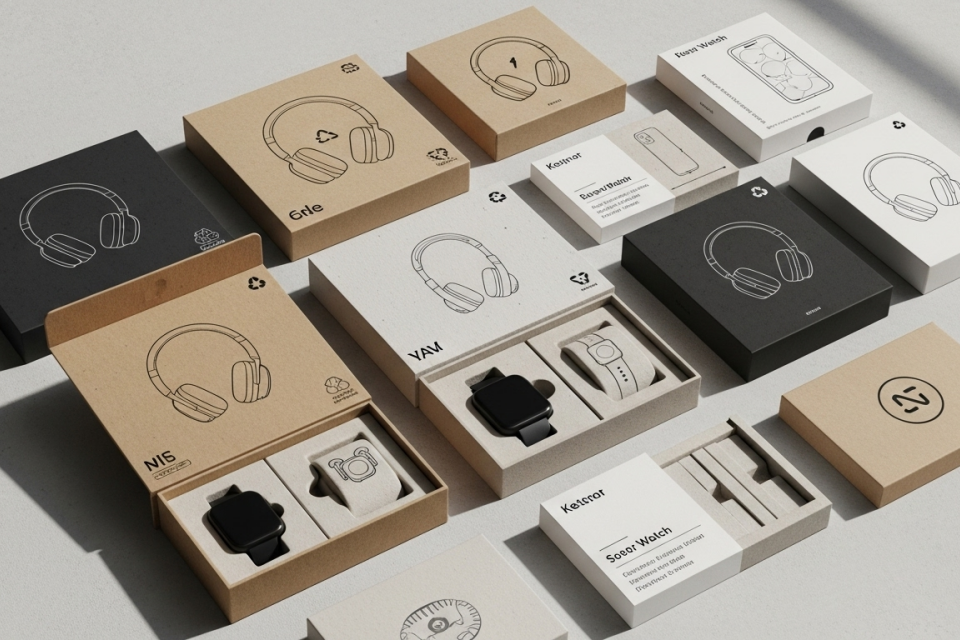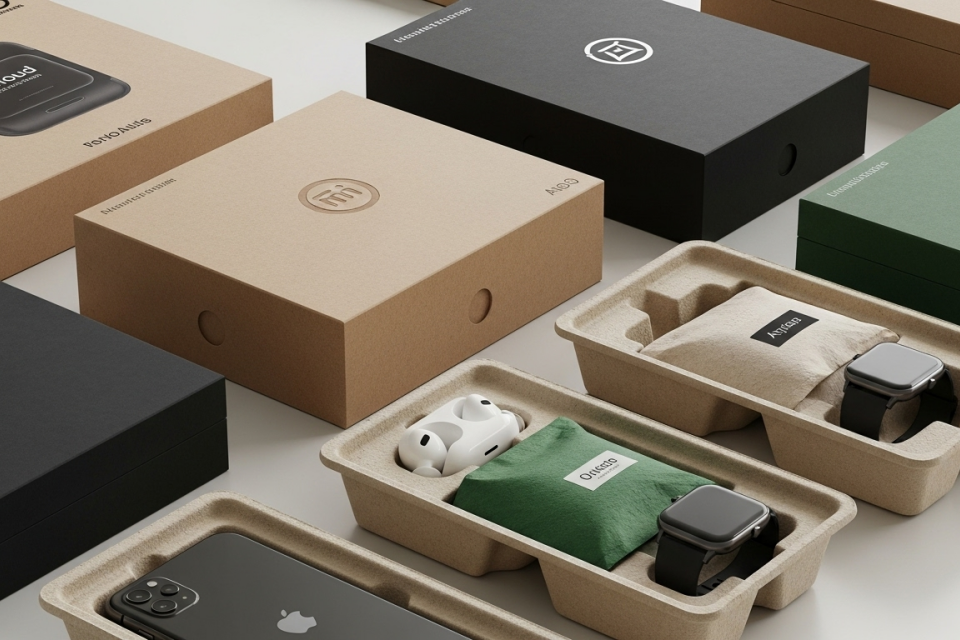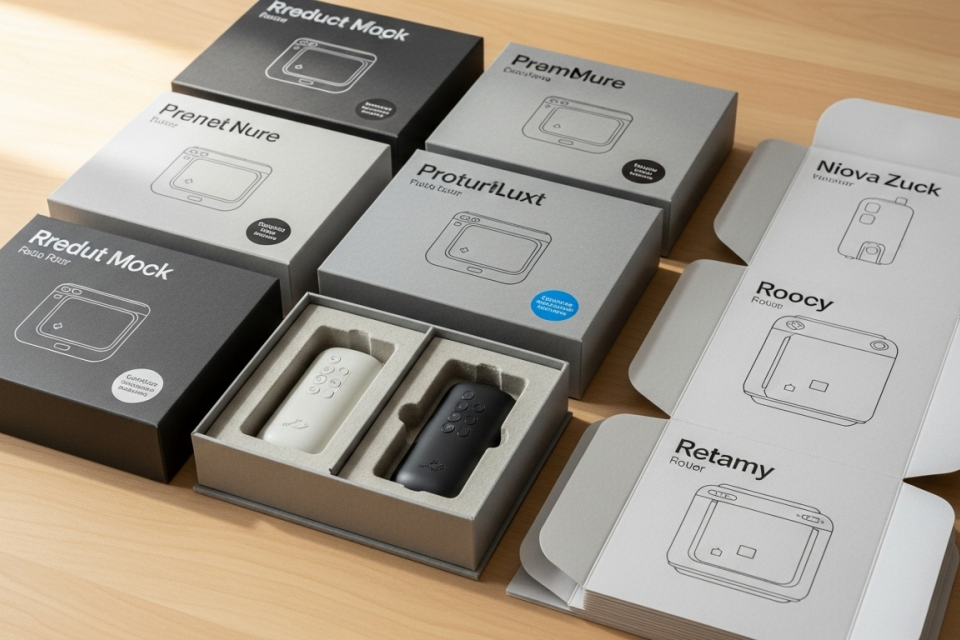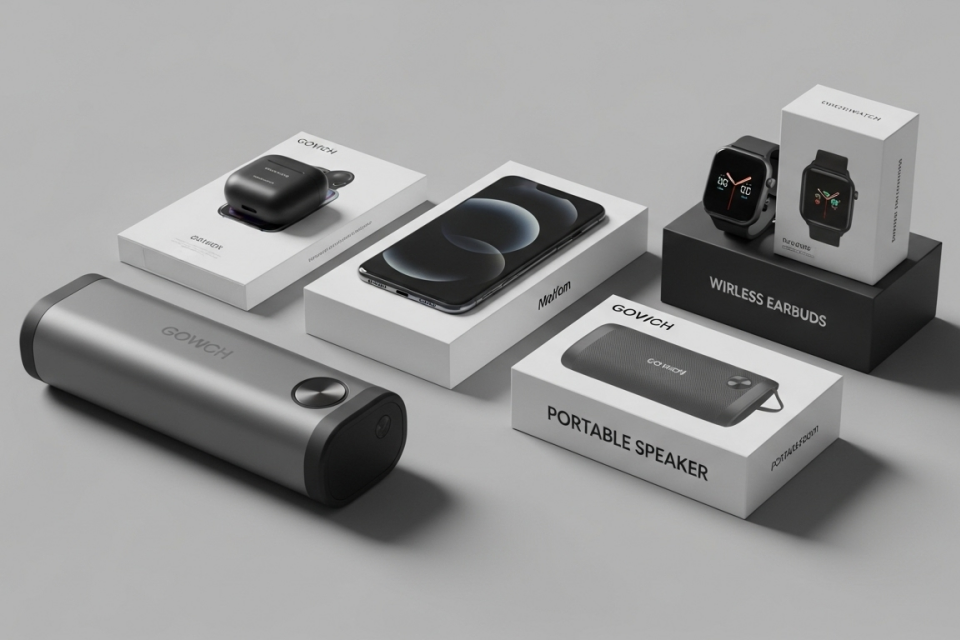Designing Custom Tech Product Boxes
This article explores custom tech box design, covering materials, sustainability, and trends for an impactful unboxing experience.
Summary
Designing custom tech product boxes involves the creation of packaging that is both functional and aesthetically pleasing, tailored specifically for technology items. As technology continues to advance and consumer expectations evolve, the importance of well-designed packaging has become increasingly prominent in the market. Custom tech product boxes not only serve to protect and preserve the items within but also play a critical role in branding, consumer engagement, and environmental sustainability, making their design an essential consideration for manufacturers and marketers alike.
The significance of custom tech product box design lies in its ability to enhance user experience while reflecting a brand’s identity. Effective packaging can communicate key brand values, create memorable unboxing experiences, and encourage repeat purchases. In an era where first impressions are vital, brands leverage innovative materials and design techniques to capture consumer attention on crowded retail shelves and digital marketplaces. As a result, the packaging process has transformed, incorporating advanced technologies, sustainable practices, and user-centric approaches to meet the demands of modern consumers.
Notable trends in custom packaging design include minimalism, personalization, and sustainability. Minimalistic designs focus on clean lines and simplicity, allowing the product to take center stage, while personalized packaging resonates emotionally with consumers by reflecting their individual preferences. The growing emphasis on sustainability has driven brands to adopt eco-friendly materials and practices, aligning with consumer demands for responsible consumption and environmental stewardship. Additionally, the integration of technology, such as augmented reality and smart packaging, enhances consumer interaction and engagement with the product, creating a more immersive experience.
Despite the advantages, the design of custom tech product boxes is not without challenges. Balancing aesthetics with functionality can be complex, as packaging must protect delicate tech items while also being user-friendly and visually appealing. Brands face the need to innovate continuously, utilizing feedback and market trends to refine their packaging strategies and address potential shortcomings in usability and consumer satisfaction. Such considerations are critical for fostering brand loyalty and maintaining competitiveness in an ever-evolving marketplace.
Table of Contents
Design Considerations
When designing custom tech product boxes, several key considerations must be taken into account to ensure the packaging effectively meets both functional and aesthetic requirements.
Material Selection
The choice of material significantly impacts the perceived quality and sustainability of the product. Various packaging materials each have unique advantages and disadvantages. For instance, clear polyester laminated films, such as CareClear, allow for product visibility, enhancing consumer engagement. On the other hand, materials like CareFoil offer superior barrier properties, making them ideal for preserving shelf life, while Care Kraft provides a natural look without compromising on functionality. Furthermore, eco-friendly options like CareRecycle and CareCompost are essential for brands prioritizing sustainability.
Technical Aspects
Designers must also address the technical specifications of packaging. This includes dimensions, bleeds, and print specifications, which are critical for ensuring that the final product meets the intended design requirements. Additionally, sustainability considerations should be factored into material choices, particularly for brands with a customer base that values environmental responsibility.
Compliance and Legal Considerations
Incorporating key elements such as colors, typography, imagery, and size is essential in product packaging design. Proper sizing is crucial to accommodate the product and any additional packaging materials, ensuring both protection and brand visibility. Designers must balance aesthetics with functionality, as visually appealing boxes that fail to protect the contents can undermine the packaging’s purpose.
User Testing and Feedback
To enhance the design process, incorporating user testing is advisable. Presenting the packaging design to a sample group from the target audience can provide valuable insights into visual appeal, clarity of information, and ease of use. This feedback can help identify potential issues that may not be evident during internal reviews.
Brand Identity and Color Psychology
Maintaining a consistent color palette is vital for reinforcing brand identity and enhancing recognition on store shelves. The psychological impact of color cannot be overlooked; for instance, blue can convey trust, while red may evoke urgency, influencing consumer purchasing behavior. Thus, strategic color selection should align with the brand’s values and the emotions they wish to evoke in consumers.
By thoughtfully considering these aspects, designers can create custom tech product boxes that not only protect the product but also effectively communicate the brand’s identity and appeal to the target market.

Functional Aspects
In the realm of designing custom tech product boxes, functionality is a critical element that significantly influences user experience and brand perception. A well-constructed packaging solution not only serves to protect the product during transport and storage but also enhances usability and consumer satisfaction.
Usability Features
Beyond protection, the usability of packaging is paramount. Innovations in design, such as easy-to-open containers, resealable options, and stackable formats, greatly improve consumer interaction with the product. These features not only enhance convenience but also encourage repeat purchases and foster brand loyalty. For instance, products packaged in a way that simplifies handling tend to see increased usage and consumer approval, particularly in fast-paced environments where time efficiency is crucial.
Durability and Protection
Material durability is essential in ensuring that tech products arrive at their destination in optimal condition. High-quality materials shield the product from damage, reinforcing the brand’s reputation for excellence and reliability. Features such as barrier protection against oxygen, moisture, and dust are vital, particularly for electronics that require a clean and sterile environment to maintain functionality.
Sustainability Considerations
The integration of sustainable materials into packaging design has become increasingly important. Consumers are more eco-conscious than ever, and brands that adopt sustainable practices can differentiate themselves in a saturated market. Using recyclable or biodegradable materials not only reflects a brand’s commitment to environmental responsibility but also resonates with consumers who prioritize sustainability. Furthermore, minimalist designs that reduce excess packaging contribute to lowering waste, aligning with the growing trend towards eco-friendly practices in product design.
Consumer Engagement
Enhancing the unboxing experience is another functional aspect of tech product packaging. Creative box designs that utilize sensory triggers—such as visual appeal and tactile elements—can significantly improve consumer satisfaction and engagement. Innovations such as augmented reality features that interact with smartphones can create memorable experiences, further solidifying a brand’s presence in the consumer’s mind.
Advanced Technologies
The adoption of advanced design technologies, such as computer-aided design (CAD) and parametric design, allows for greater flexibility and precision in packaging design. These tools enable designers to create adaptable packaging that accommodates various product sizes while optimizing for material usage and environmental impact. Additionally, the use of robotics in packaging processes can enhance efficiency and sustainability by minimizing waste and energy consumption.

Production Process
The production process of custom tech product boxes has evolved significantly, particularly with the integration of advanced technologies that enhance efficiency, accuracy, and sustainability.
Automation and Al Integration
In 2024, the focus on cost-effectiveness and efficiency in production has led to the adoption of automation and Al-driven systems in box design. These innovations minimize human error and accelerate production times, thus reducing labor costs and improving consistency in quality across batches. Automated assembly lines and robotics have become integral, streamlining tasks from printing to die-cutting and quality control, which collectively reduces lead times and increases the potential for mass production.
Digital Prototyping and CAD Technology
The introduction of computer-aided design (CAD) has revolutionized the packaging design landscape. Early adopters of CAD benefited from faster market launches and higher quality packaging by simulating designs virtually, thereby minimizing the risks associated with costly errors and product recalls. The evolution of CAD, particularly with 3D modeling capabilities, has enabled designers to create complex, highly detailed packaging solutions that are both functional and visually appealing. Digital prototyping further supports this by reducing the need for physical samples, thereby speeding up the design process and cutting down on material waste.
Sustainable Practices
As environmental concerns grow, the packaging industry is increasingly leaning towards sustainable and circular design principles. This shift involves utilizing eco-friendly materials and encouraging practices that promote reuse and recycling. Innovations such as bio-based plastics, compostable films, and lightweight materials are becoming more prevalent as brands prioritize sustainable packaging solutions. The integration of lifecycle analysis software helps designers assess the environmental impact of their packaging throughout its lifecycle, from production to disposal, ensuring sustainability is embedded in every stage of the design process.
Enhanced Skills and Collaboration
The evolution of the packaging production process requires enhanced technical skills among designers and industry professionals. Learning about new materials, advanced printing techniques, and interactive design principles is essential to keep pace with these advancements. Additionally, modern collaboration tools enable real-time feedback and centralized access to design files, which streamlines the review process and enhances communication among stakeholders.

Trends in Custom Packaging Design
Personalization
Personalized packaging is another trend that is gaining traction, particularly with the rise of e-commerce and direct-to-consumer brands. This trend allows companies to create packaging that reflects the individual preferences of their customers, such as designs tailored for specific occasions or aligned with the recipient’s personal style. By utilizing technology for customization, brands can foster emotional connections with consumers, enhancing user experience and driving brand loyalty.
Minimalism
One of the most prominent trends in custom packaging design is minimalism. This aesthetic focuses on simple, clean lines and a reduction of unnecessary elements, allowing the product to take center stage. Brands like Apple have effectively employed this approach, using sleek designs that highlight the product rather than overwhelming it with excessive graphics. Minimalist packaging not only conveys sophistication but also enhances brand recognition, enabling consumers to easily identify products on store shelves. This clarity often leads to increased trust and loyalty among customers, who appreciate a straightforward and no-frills approach to packaging.
Sustainable Practices
Sustainability has become a critical focus within custom packaging design. Companies are increasingly prioritizing eco-friendly materials, such as biodegradable composites and recyclable packaging, to reduce their environmental footprint. This shift is driven by consumer demand for environmentally responsible practices and regulatory compliance. For instance, major corporations like Unilever and Nestlé have committed to making their packaging recyclable or compostable by 2025, reflecting a broader movement towards sustainable packaging solutions in the industry.
Technological Advancements
Technological advancements are reshaping the landscape of packaging design, introducing interactive elements that engage consumers in novel ways. Augmented reality (AR) features, for example, allow consumers to interact with products through their smartphones, enhancing the overall experience. Additionally, innovations like smart packaging with sensors and tracking capabilities provide consumers with more information about the product, further enriching their engagement.
Versatility
Versatile packaging designs are also gaining popularity, with products that can be reused or serve multiple purposes after purchase. This trend appeals to modern consumers who value sustainability and practicality, as reusable containers or multi-functional packages can significantly reduce waste while enhancing the overall user experience.

Case Studies
Successful Deployments of Custom Box Solutions
Custom box solutions have gained traction across various industries, particularly in manufacturing, e-commerce, and logistics. Real-world examples illustrate how companies have effectively integrated these technologies, leading to enhanced shipping efficiency and reduced packaging waste. For instance, manufacturers utilizing automated box-making machines report significant long-term savings through lower material usage and improved operational efficiency, despite the substantial upfront investment required.
Innovative Box Design and Consumer Engagement
The trend of integrating innovative box designs has not only focused on sustainability but also on enhancing user experience. Although specific case studies from 2024 remain proprietary, general trends indicate that successful packaging designs combine eco-friendly materials with technology integration, resulting in higher consumer satisfaction and brand loyalty. Companies like Apple have leveraged minimalistic packaging designs that convey innovation, creating a memorable unboxing experience that resonates with consumers. Similarly, Coca-Cola’s “Share a Coke” campaign utilized personalized packaging to foster customer engagement and boost sales, demonstrating the impact of tailored packaging solutions on brand identity and consumer interaction.
Lessons from Iconic Brands
Examining successful packaging strategies employed by well-known brands reveals the significance of thoughtful design in influencing consumer behavior. Brands such as Apple, Coca-Cola, and Tiffany & Co. have effectively utilized packaging not only to protect their products but also to communicate their brand values and reinforce recognition. Apple’s commitment to sustainable packaging, for example, showcases how a brand can align its packaging strategy with environmental responsibility, further enhancing customer loyalty. The clean, elegant designs used by luxury brands signal quality and exclusivity, which can lead to increased consumer trust and sales.
Future Trends and Innovations
As the packaging industry evolves, the integration of smart technologies and innovative design techniques is expected to continue driving improvements in supply chain efficiency and environmental impact. The use of customizable, right-sized packaging solutions is becoming increasingly prevalent, allowing businesses to adapt to changing consumer demands while minimizing waste. Tracking these developments throughout 2024 and beyond will provide further insights into how companies are capitalizing on custom box solutions to differentiate themselves in a competitive market.
Consumer Feedback and Evaluation
Assessing Consumer Willingness to Pay for Sustainability
Understanding consumer willingness to pay a premium for sustainable packaging is crucial for brands aiming to align their offerings with eco-friendly practices. Surveys and interviews can provide valuable insights into consumer support for green initiatives, indicating that companies might see substantial returns on their initial investments in sustainability over time due to increased consumer loyalty and engagement.
Gathering Feedback on Packaging Changes
Continuous evaluation of consumer responses to packaging changes is essential for brands. This can be achieved through direct feedback mechanisms such as surveys, social media polls, and interviews, enabling companies to gauge consumer opinions on new materials and designs. It is critical to determine if the changes meet consumer expectations or if further adjustments are needed. By analyzing sales data alongside consumer feedback, businesses can refine their packaging strategies to better resonate with their target audience.
Techniques for Effective Feedback Collection
A variety of techniques can be employed to gather consumer feedback effectively. These include customer surveys that assess brand recall and recognition, as well as the perceived effectiveness of packaging design. It is vital for businesses to outline what success looks like in terms of consumer perception, brand visibility, or sales growth before proceeding with the evaluation of their branding and packaging efforts.
Importance of User Testing
Incorporating user testing into the packaging design review process can yield invaluable insights. Presenting packaging designs to a sample group from the target audience allows for direct feedback on visual appeal, clarity, and functionality. This process can highlight potential issues that may not be evident during internal reviews.
Utilizing Eye Tracking Research
Eye tracking research has emerged as a valuable tool for assessing packaging effectiveness. By observing shopper behavior and how they engage with packaging on the shelf, brands can gather data on what elements draw attention and which aspects may be overlooked. This method helps to refine packaging designs to enhance consumer interaction and product visibility.
Analyzing Demographic Data
Collecting and analyzing demographic data can further inform packaging strategies. For instance, a study involving urban consumers in Mumbai revealed key demographics such as age, education, and gender, which can influence preferences and perceptions of packaging. This data can guide brands in tailoring their packaging to better fit the specific characteristics of their target audience.
Challenges and Solutions
Common Packaging Challenges for Tech Products
Designing custom tech product boxes presents unique challenges that can impact both functionality and consumer perception. One significant issue is ensuring that the packaging not only protects the product during transit but also enhances the unboxing experience for consumers. As consumers increasingly seek user-friendly designs, any difficulties in opening packages can lead to negative perceptions of the brand.
Additionally, tech products often require specialized packaging to accommodate various sizes and shapes, leading to complexities in material selection and structural design. This complexity can make it challenging for small businesses to compete with larger brands that have more extensive resources and marketing budgets. For small-batch manufacturers, finding the right suppliers that can deliver customized solutions while maintaining cost-effectiveness is vital.
Solutions to Packaging-Related Issues
To address these challenges, companies can adopt several strategies. Implementing user-friendly designs that prioritize easy opening can significantly improve consumer satisfaction. This may include features such as tear strips or easy-to-peel seals that enhance accessibility without compromising the integrity of the packaging.
Furthermore, leveraging innovative materials, including eco-friendly options, can enhance brand image while meeting consumer demand for sustainability. Brands should consider incorporating smart technology into their packaging designs to provide added functionality and connectivity, which can appeal to tech-savvy consumers.
Engaging in continuous consumer feedback processes is also essential. Conducting surveys, focus groups, or social media polls allows brands to gather insights into consumer preferences regarding packaging aesthetics and usability. By synthesizing this qualitative feedback with quantitative data on packaging performance, businesses can refine their strategies to align more closely with consumer expectations and market trends.
The Role of Aesthetics and Functionality
Aesthetics play a crucial role in packaging design, particularly for tech products, where shelf appeal can significantly influence consumer attraction. Utilizing bold colors, unique shapes, and tactile elements can set a product apart from competitors and create a memorable experience for the consumer. Brands should strive to balance functional requirements with compelling visual design, ensuring that their packaging resonates with target audiences while fulfilling practical needs.
